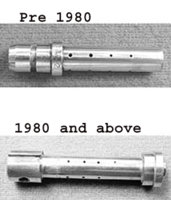Rexxis
Almost there...
Running the 750 kit w open intake and exhaust. Nearing the end of my build and this is the first time the bike has ran since I bought it. Bike revs crazy high on start-up. No tach but I'd guess it's around the 5k range.
Throttle cable is good and slides are sitting at bottom and return when pushed up. Diaphragms are good and slides fall slowly when the crescent shaped port at top of intake bell is covered. Idle screws are turned 2.25 turns out. Factory setting for my year. Any other settings I should be concerned with?
Jet sizes currently
Main 140
Pilot 30
Originals that were in my carbs(carbs are not the originals that came w my motor)
Main 135
Pilot 27.5
I checked and the bike was previously using the factory size jets so that means I definitely only went 2+ on mains and 1+ on pilot. I was worrying that maybe a PO had already upped the jets and I was upping it even more but this is not the case.
The change in jetting wouldn't cause such a drastic increase in RPM's would it? I would think that changing the main by two sizes might increase the RPM's a little but to nearly what I would guess is around the 5k range.. I think something else is going on. I really don't know though as my experience is next to nothing.
Could a vacuum leak cause such a drastic response to RPM? My carb boots were abt as hard as rocks.. New ones just arrived and will replace soon as air barb plugs and proper hose clamps arrive. I've got the gaskets between head and boots but I didn' use any gasket glue, should I use some kind of gasket glue? I just hate scraping gaskets so when the carbs have to come off again(which I know they inevitably will), I didn't want to have to scrape and replace the gaskets every time.
I'm hoping one of you gurus will see this soon and maybe be able to get me pointed in the right direction. I'm pretty much stumped right now and I have a feeling the new boots aren't the solution, but hey, I needed new ones anyway.
Throttle cable is good and slides are sitting at bottom and return when pushed up. Diaphragms are good and slides fall slowly when the crescent shaped port at top of intake bell is covered. Idle screws are turned 2.25 turns out. Factory setting for my year. Any other settings I should be concerned with?
Jet sizes currently
Main 140
Pilot 30
Originals that were in my carbs(carbs are not the originals that came w my motor)
Main 135
Pilot 27.5
I checked and the bike was previously using the factory size jets so that means I definitely only went 2+ on mains and 1+ on pilot. I was worrying that maybe a PO had already upped the jets and I was upping it even more but this is not the case.
The change in jetting wouldn't cause such a drastic increase in RPM's would it? I would think that changing the main by two sizes might increase the RPM's a little but to nearly what I would guess is around the 5k range.. I think something else is going on. I really don't know though as my experience is next to nothing.
Could a vacuum leak cause such a drastic response to RPM? My carb boots were abt as hard as rocks.. New ones just arrived and will replace soon as air barb plugs and proper hose clamps arrive. I've got the gaskets between head and boots but I didn' use any gasket glue, should I use some kind of gasket glue? I just hate scraping gaskets so when the carbs have to come off again(which I know they inevitably will), I didn't want to have to scrape and replace the gaskets every time.
I'm hoping one of you gurus will see this soon and maybe be able to get me pointed in the right direction. I'm pretty much stumped right now and I have a feeling the new boots aren't the solution, but hey, I needed new ones anyway.
Last edited:


 nicely before installation as well.
nicely before installation as well.






 Air screws? They should be what, abt 1 1/2 turns out? I will double check the idle screw once the carb boots come in and I can get the carbs back on the bike. With the carbs sitting here on my desk, the idle screw is adjusted so that the plates are fully closed.
Air screws? They should be what, abt 1 1/2 turns out? I will double check the idle screw once the carb boots come in and I can get the carbs back on the bike. With the carbs sitting here on my desk, the idle screw is adjusted so that the plates are fully closed.